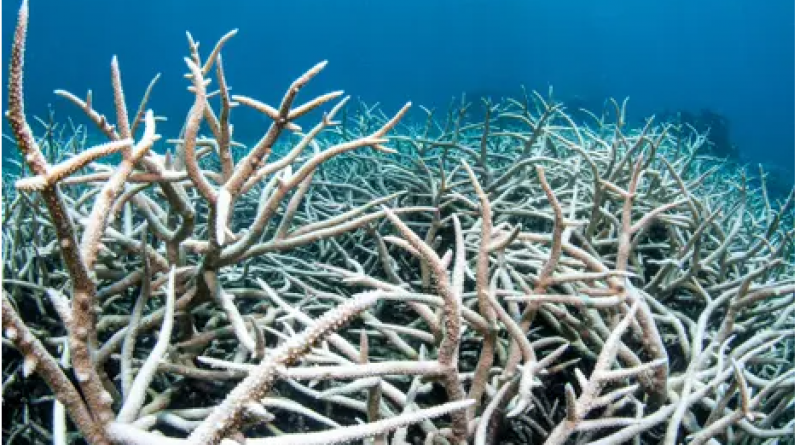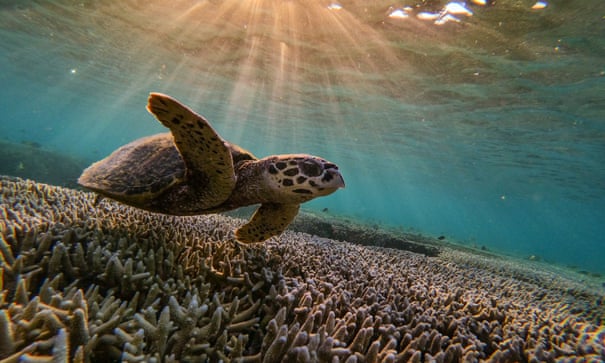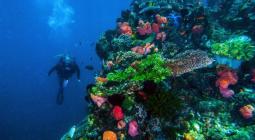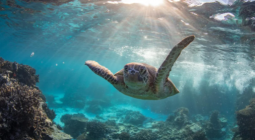Great Barrier Reef’s future dealt blow as study finds only 2% escaped coral bleaching

New research comes months after Australian government lobbied to keep coral reef off world heritage ‘in danger’ list
Hopes that enough of the Great Barrier Reef could escape global heating long enough for it to recover have been challenged by research finding less than 2% of its coral reefs have escaped bleaching since 1998.
The world’s largest coral reef system has suffered five mass bleaching events in that time – caused by rising ocean temperatures driven by the burning of fossil fuel – which have undermined its survival. The most recent event was the most widespread yet.
In a study released on Friday, James Cook University’s Prof Terry Hughes and colleagues studied the locations of bleaching events and found only 1.7% of individual reefs had avoided bleaching. Almost all of the places that escaped damage were in an area known as Swain reefs in the southern section of the world heritage listed marine park.
Some reef experts hope cooler areas will act as refuges from bleaching, enabling corals to survive and naturally disperse their larvae on to damaged reefs.
But the research in the journal Current Biology found areas “earmarked earlier as candidate refuges” had now experienced severe or moderate bleaching at least once.
“The world is now littered with former potential coral reef refuges that have since bleached,” leading reef expert Hughes said.
Hughes said reefs would struggle to survive even if countries were successful in meeting pledges made at the ongoing Cop26 climate talks in Glasgow.
Tropical reefs are one of the world’s most susceptible ecosystems to climate change, with widespread impacts already being seen with global heating at 1.1C.
When corals sit in unusually warm water for too long, they separate from the algae that give them most of their food and their colour.
In extreme cases this bleaching can kill the coral. Very high temperatures can also kill corals outright.
Analysis of the latest emissions pledges at the Glasgow climate summit this week found if all countries were to meet their targets then there was a 50-50 chance that warming could be kept below 2C.
Hughes said a drastic cut in greenhouse gas emissions by all countries was vital for the future of corals reefs.
“So far 1.1C [of warming] has been sufficient to trigger five mass bleaching events,” he said.
“The higher the temperature goes, the more difficult it will be. I am confident [corals reefs] could handle another 0.3C of warming, but they will struggle at 1.9C and there’s a lot of optimism in that 1.9C figure.”
Coral larvae drops sharply
Research in 2019 suggested the back-to-back mass bleaching of corals in 2016 and 2017 had caused a crash in the amount of coral larvae being produced.
A separate study published on Friday, also in Current Biology, estimates the number of baby corals being produced across the reef had dropped by 71% since the first mass bleaching event in 1998.
The study used a model to estimate how much coral larvae – the free-floating coral offspring – was being produced across the reef.

The drop in larvae was undermining the reef’s resilience, the study said. But some areas continued to avoid the worst of the bleaching and these could keep supplying other parts of the reef with coral larvae in the future, and should be a focus of conservation efforts.
The University of Queensland’s Prof Peter Mumby, a co-author of the study, said these coral “refugia” were on the outer reef and close to strong currents.
“We don’t yet know how long those thermal refuges will exist. They won’t last forever,” he said.
“There are still healthy reefs producing larvae, but if we see these patterns [of warming] continue you would expect it would affect rates of coral recovery. One of the biggest concerns is even if we can stick to the 1.5C target, we still have committed warming.”
Earlier this year the World Heritage Committee agreed not to put the reef on a list of its “in danger” sites, against the recommendations of United Nations Educational, Scientific and Cultural Organisation experts.
The Australian government had lobbied furiously against the recommendation, saying that while climate change was the reef’s biggest threat the appropriate forum to tackle climate change was the UN’s climate convention.
Since then, the Morrison government has refused to set stronger climate targets for 2030, and has claimed promoting growth in new technologies will be enough to see the country reach net zero emissions by 2050.
The World Heritage Committee is due to consider again whether to place the reef on its in danger list at next year’s annual meeting in Russia.
4 November 2021
The Guardian



